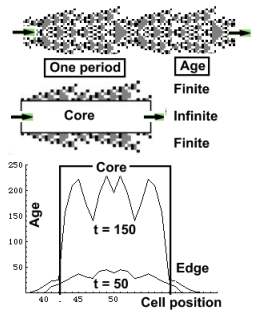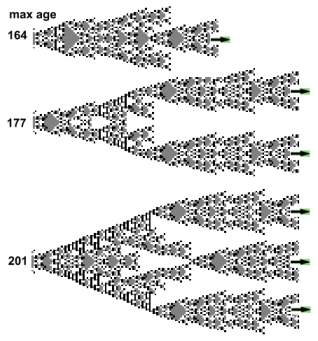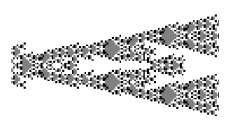 |
Process fission
Isolated process
We continue the experiments which started in chapter
47. Experiments start when CA-1 reached steady state
(a solution), and CA oscillates at
a period = 46. Cells on
the rim are short lived,
while the inner cells live for ever and
'accumulate age'. Although CA structure
maintains steady state, age structure does not. Core age continually
increases. The lower graph depicts two age distributions. While
core age rises, cell age at the edge oscillates about a constant value.
 |
Age injury
The following experiments started 200 time units after the zygote was planted . Then 'max age' was lowered.
When this happens cells with ages greater than 'max age' die. Max age
lowering is a way to reset the internal clock of the cell. Each experiment
was repeated many times In each round the response of CA to a
given 'max age' was investigated. Many CA died, other became chaotic.
The lower image depicts three interesting examples. At max age = 164.
CA cells in the core started dying. Then a cell in the middle,
which looks like a zygote, took over and generated a new CA. It is a stem
cell and not a zygote. Zygote is a cell whose color is gray ( = 1) and
age = 0. . Such a cell appears only
in the beginning of the experiment. A stem cell inherits its age from its parent of the previous state and its age
> 0. The stem cell generates a
new CA whose age structure
differs from that of a zygote generated CA. (compare
with chapter 37). At max ages = 177 and 201 the CA split respectively into two and
three CA.
 |
A process does not split along its axis into two halves. Cells cannot move sideways, since each state depicts the CA structure at a given time 'i'. When a cell at t = i intends to move, it changes its position at t = i +1. A new process is generated either from an isolated stem cell, or a small cluster of stem cells like in the image below. This experiment started 100 time units after zygote planting, and max age =112.
 |
Age injury
First let's distinguish between CA appearance, or somatic
structure, and its age structure. Two isolated processes with the same somatic structure
may differ in their age structures. This difference can be assessed when
the process is challenged. In previous experiments, CA was challenged by
injuring its somatic structure (v. chapter 25), here
we injure (change) its age structure. Elevating cell's age advances it closer
to max age, when it dies. Lowering its age makes it younger. In both cases
the outcome may vary since it depends on the somatic structure.
Apoptosis
Programmed cell death is called apoptosis. Cells in the body are programmed when to die .Lowering of age max induces apoptosis in the CA, which leads to CA death, or the creation of a new process. In the embryo apoptotic cells are replaced with invading stem cells, which generate new organs (processes).
Setup
zygote -> effect[1, 1000]; go[200];
storeparams; restoreparams;
effect[1.mm]; go[200]